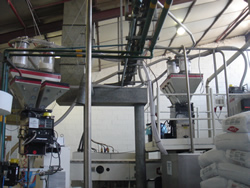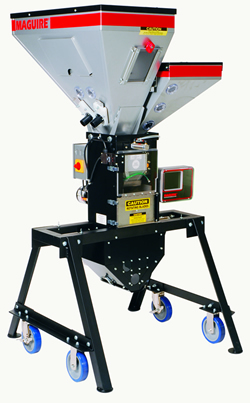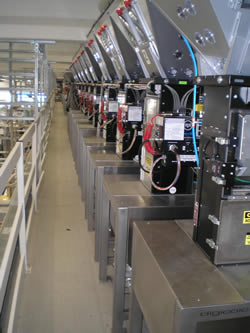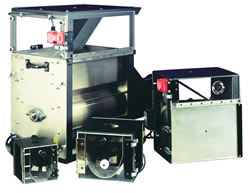Process Integration and Layout-Blenders
.jpg)




Automatic, multi-component blenders are typically installed in four common configurations:
- On the process machine
- Beside the process machine
- Mobile
- Central
On the processing machine installation: In these installations, the blender is integrated into the process flow directly, and all materials entering the machine throat into the process, flow through the blender. This type of installation provides the greatest mix integrity since blended materials have no opportunity to separate between the blending operation and the process. Typically, gravity provides the flow to the process and usually the demand for blending is created by the process flow itself, via a sensor in the mix chamber of the blender. In some extrusion applications, material is not flood fed into the machine throat, but metered by an auger for ‘starve feeding’ the process to allow for a more uniform process.
The blender frame is installed onto the throat of the process via an adaptor plate that matches the blender base to the processing machine throat bolt pattern. In some cases, a small riser is required to funnel the blender flow into the machine throat opening. A starve-feeding auger is included in this stack-up for some extrusion operations. Since the blender and its associated loading equipment and other peripherals can be heavy, the integrity of this installation is critical to assure the structural security of the final installation. The blender may also be supported by a structure suspended above and over the process, like a mezzanine or a platform that can simplify blender access for set-up, cleaning and service. When the blender outlet is located some distance from the process machine throat, a material flow valve is typically installed beneath the blender to retard the flow of material and allow for blending time in the mixing chamber, and to minimize the amount of material ‘backed up’ in the connecting tube between the blender and the process machine throat. The flow valve responds to the need for material at the process by opening the valve and allowing blended material to flow, but only after a sufficient mix time is accommodated for the materials.
Beside the Process Machine Installation: Processors who frequently change colors or materials often benefit by placing the blender beside the processing machine instead of on it. The blender remains fully serviceable at floor level and a conveying system transfers the blended material to the machine throat. In some cases, the machine throat is not optimum for the location of a piece of machinery and a beside-the-process location is best, IE: blow molding machinery with moving, vertical processing screws.
The blender is mounted on a floor stand, optimized for the blender and equipped with a material take-off box for conveying the blend. A flow regulator valve is included beneath the blender to assure sufficient mix time, prior to the blended material free-falling into the take-off box. For non-critical mixes, the flow regulator valve is not required and the take-off box is flood fed.
Special care should be taken when planning a beside the process installation to assure that valuable floor space is used wisely. It is common for blending applications be accompanied by material storage vessels, further consuming space. Many processors find it advantageous to consider a mobile blending cart by simply adding casters to the floor stand, in lieu of a permanent blending installation on the floor. Options, such as easily removed additive bins and even pneumatic elevators for the loading equipment are especially well-suited for rapid material/color changes.
Mobile Blending Installations: For maximum flexibility, making the blender mobile on a wheeled frame makes the most sense in many cases. Only small to medium blenders are candidates for this feature. The blender is mounted on a frame (similar to beside-the-process installations) but equipped with casters, allowing the blender to be wheeled as needed to serve another processing machine, to be serviced or cleaned, etc.
In many cases, a mobile blender is equipped to serve the specific needs of the user and to be easily integrated into the process and facility in which it is employed. The conveying system(s) supplying the bins need to be accommodated to allow mobility of the blender, either by removal and re-installation of the receivers or through the use of self-contained loaders. Compressed air and power connections for all components (blending and loading) must be considered along with whatever conveying method is used to get the material from the blender, to the process. Lightweight and simple compressed air loading devices are often considered for low volume material transfer, to and/or from the blender.
Central Blending Installations: Using a single blender to serve the needs of multiple processing machines is an approach often used by captive molders or any processor running the same blend for multiple products. In these installations, the blender is located in a central area and either connected to each end-use machine by a material conveying system, or the blender provides a supply of material to storage vessels (IE: gaylords or barrels) that can be transported as needed to the process machines (or a combination of both these methods). Concern should be given in either of these scenarios to the likelihood of the blend separating during conveying, storage and/or transport. In terms of blend integrity, direct feeding of the blend to the process by machine mounting is best but machine mounted mixers may be utilized to ensure a good blend if ingredients. However, for many processors, requiring low precision in their blends, central blending is used quite satisfactorily. When possible, the use of take-away conveying devices that capture and convey a given volume of blended material (IE: purge valve) are best for retaining blend integrity. These devices are less likely to allow light and heavy materials to separate in conveying, since a given quantity is conveyed with each transfer cycle, and that same quantity is delivered to the process. This type of device is controlled by the conveying system and may require complex accommodations if utilized for a number of destinations. Most conveying systems are not equipped for this level of sophistication unless designed accordingly.
Central blenders are often larger models, providing higher volumes of blended materials to serve the demands of several process machines. But frequently, processors choose to centralize all of the blenders required for their operation and place them in a centralized location for easy material supply and material change operations. In these cases, dedicated personnel can be placed in charge of all blending and material change operations for the entire plant.
A permanent installation is most common, with accommodations made for conveying and/or dumping into storage vessels that will be moved to and from the area below the blender. Floor stands, floor stands with extended legs, platforms and mezzanines are all common mounting considerations for central blenders. A central blender can be most easily outfitted with conveying machinery since material changes are typically less frequent and the permanent location makes installation of loader, receivers and controls much easier.



